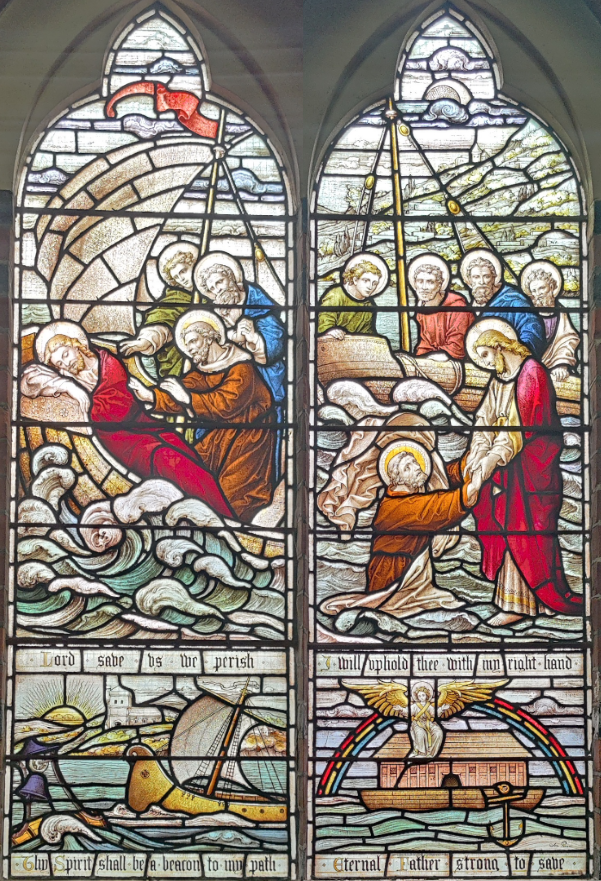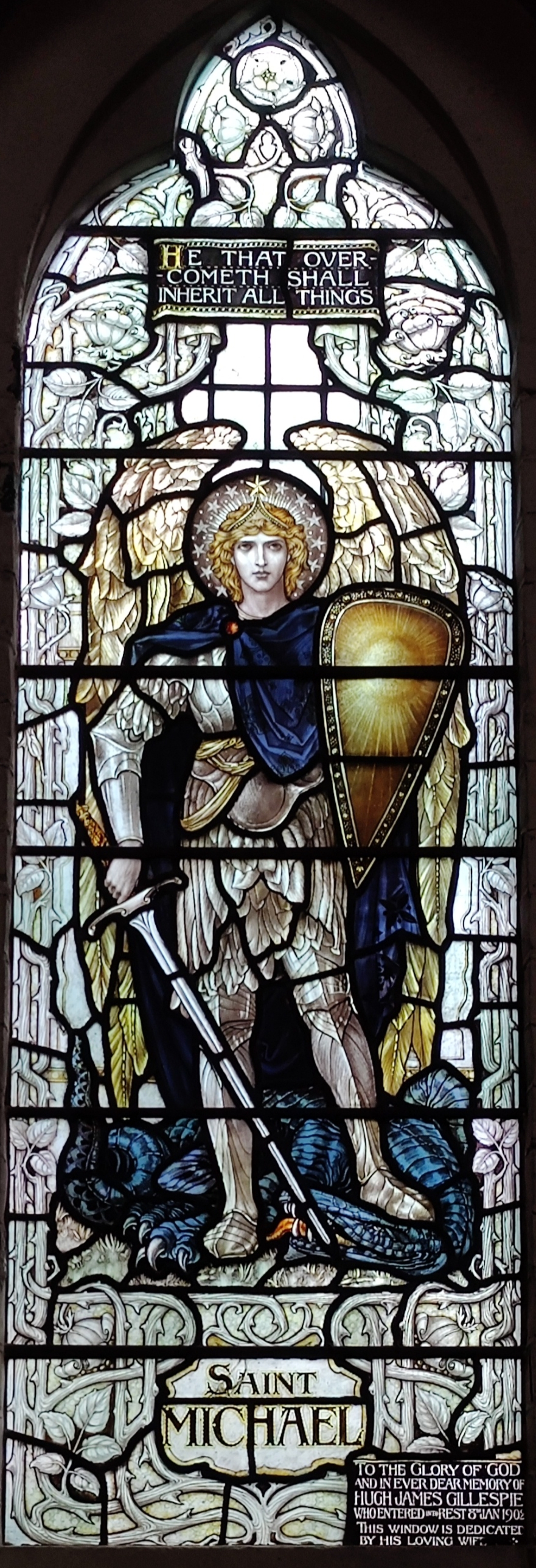This page is gradually being updated.
St Michael
The window at the eastern end of the south wall depicting St Michael is dedicated to Hugh James Gillespie and it’s likely it was installed sometime in the latter half of 1903.
Hugh died on Wednesday 8 January 1902 at his home, the Gables in Osborne Road. He was 49 years old and had been suffering from cancer for about six months. The Maidenhead and Slough Gazette of 11 January 1902 goes on to tell us that he bore “his sufferings with Christian resignation”.
The Gazette gives a short biography of Hugh. He was the youngest of two sons and was born Glasgow on 28 February 1853 to “Mr George Gillespie, a Canadian merchant and member of an old Lanarkshire family” (no mention of his mother!). He was educated at Haileybury and Cheltenham, and finally Christ Church, Oxford. He was a barrister for some years before retiring due to ill health. He had been living in Windsor for about 15 years, initially at settling at 5 Queen’s Terrace (King’s Road). He had two children from his first marriage to Miss Acton and a daughter by his second marriage to a Miss Easson of Framewood in Stoke Poges.
His eldest daughter later married Admiral Sir Henry Ruthven Moore GCB, CVO, DSO, DL (1886-1978), who was the last British admiral to command Home Fleet during the Second World War.
It goes on to say “He was first treasurer of the St John Ambulance branch in Windsor, the treasurer of the Church Schools, was a member of the Windsor Infirmary Committee, and lastly he was connected with the Soldiers’ and Sailors’ Families’ Association [which later became the well known armed forces charity, SSAFA], as Secretary for Berks and Bucks, and from the commencement of the Boer War was actively engaged in relief work. He was an earnest churchman…”. The first part of his funeral took place at All Saints’ Church (where he worshipped) on Saturday 11 January with the internment in his second wife’s family vault at Fulmer. The latter service was led by the Vicar of Fulmer and one of his brothers in law (both were clergymen).
Windsor & Eton Express of 18 January 1902 reports on the journey to Fulmer that “The procession passed through Windsor & Eton, where the closed shops and tolling of the bells testified to the universal respect in which Mr Gillespie was held…”
Denham Window

Two lights form the window dedicated to Commander Annesley Turner Denham in the south wall. The window was installed in April 1900 and the left light depicts Jesus calming the sea and the right light, Jesus walking on water. The window was designed and made by Mr J Pace (his signature is in the right hand corner) and the brass plate was designed by Mr A Y Nutt. The inscription on the brass plate, fixed on the mullion between the continued from previous page lights reads “To the glory of God, and in loving memory of Annesley Turner Denham, Commander R. N., who died June 27th, 1899, aged 64 years. This stained glass was placed here by his sorrowing widow”.
His widow was Cordelia Ellen Denham who was from a local family and died in the mid-1920s. Annesley’s funeral was held on Saturday 1 July 1899. The service started at All Saints, where he was a parishioner, and concluded at the cemetery. It was conducted by Revd J H J Ellison (vicar), Revd Canon Gee (former vicar) and the Revd Arthur Robins (Rector of Holy Trinity).
Christ calming the storm is also the subject of a window dedicated to his father, Sir Henry Mangles Denham (the famous hydrographer), in Holy Trinity. This was placed there by Emily Mangles, one of Annesley’s sisters. Emily is also responsible for the window beside Sir Henry’s which is dedicated to another sister, Alicia Eliza Parker, and the southern most light of the east window at Holy Trinity is dedicated to Emily’s husband (Captain Mangles who was in the army and died back in Windsor, having eventually succumbed to injuries received in the trenches before Sebastopol).
Annesley entered the Navy in 1848, serving with distinction in various conflicts, retiring in 1878. During his retirement he was involved with many local organisations: the Windsor District of the Prince Consort’s Association; the Windsor & Eton Royal Dispensary; Windsor National Schools; Board of Guardians (Poor Law/workhouses etc); he was chair of the first Lifeboat Saturday in Windsor in 1897 and also a supporter of the local branch of the Navy League.
Annesley was christened, aged 3 months, on Sunday 9 August 1835 on board the William Penn ship (which his father used to survey and lay down a new channel in the Mersey) by Professor Sedgwick—probably Adam Sedgwick, the geologist who was ordained and was a friend and mentor of Charles Darwin). The service was held while the ship was taking a party to Dublin and as the service began the ship came close to a buoy with a bell which rang— reminding the congregation of church bells. Due to the buoy his baptism seems to have become an anecdote that stayed with him.
Annesley and Cordelia lived at 2 Queen’s Terrace, Kings Road, and Annesley died there after a long illness. They are buried together in Spital Cemetery.
